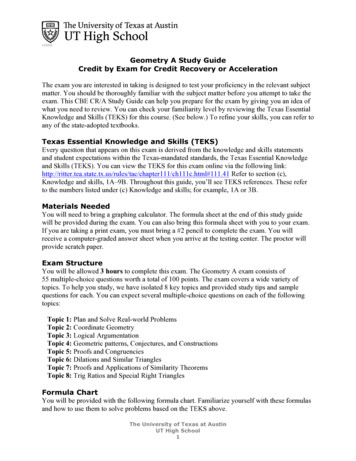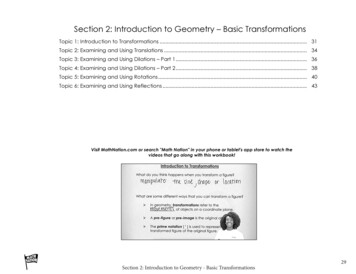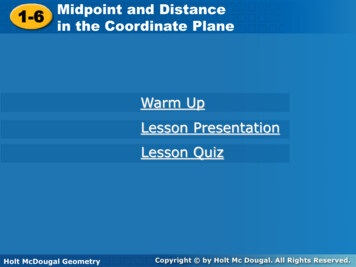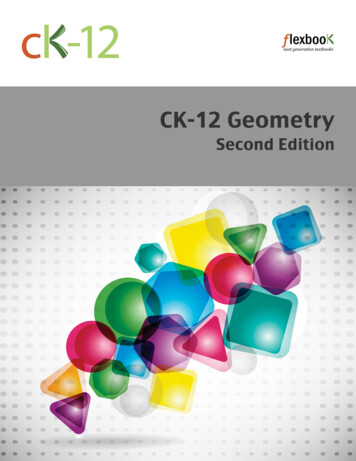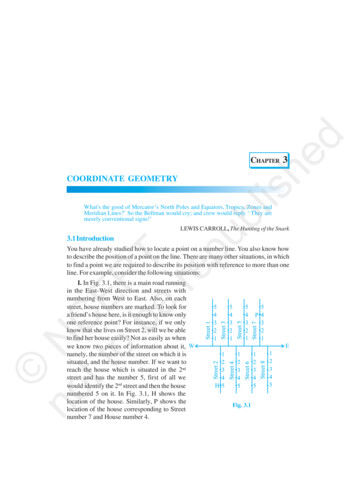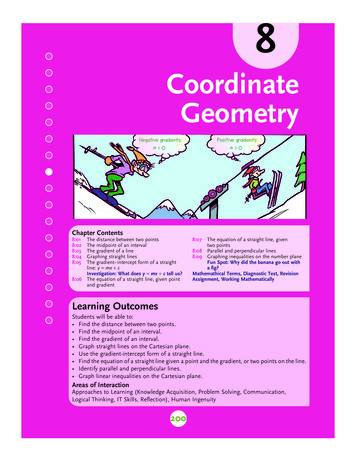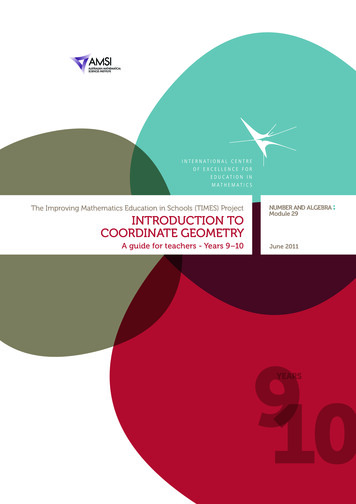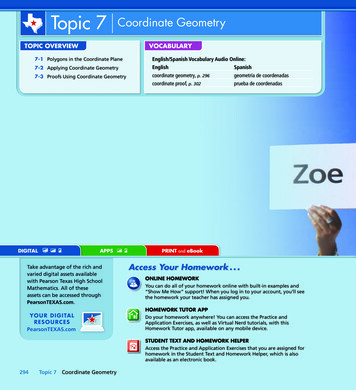
Transcription
Topic 7Coordinate GeometryTOPIC OVERVIEWVOCABULARY7-1 Polygons in the Coordinate Plane7-2 Applying Coordinate Geometry7-3 Proofs Using Coordinate GeometryDIGITALAPPSEnglish/Spanish Vocabulary Audio Online:EnglishSpanishcoordinate geometry, p. 296geometría de coordenadascoordinate proof, p. 302prueba de coordenadasPRINT and eBookAccess Your Homework . . .Online homeworkYou can do all of your homework online with built-in examples and“Show Me How” support! When you log in to your account, you’ll seethe homework your teacher has assigned you.Your DigitalResourcesPearsonTEXAS.comHomework Tutor appDo your homework anywhere! You can access the Practice andApplication Exercises, as well as Virtual Nerd tutorials, with thisHomework Tutor app, available on any mobile device.STUDENT TEXT AND Homework HelperAccess the Practice and Application Exercises that you are assigned forhomework in the Student Text and Homework Helper, which is alsoavailable as an electronic book.294Topic 7Coordinate Geometry
3--Act MathYou Bethe JudgeHave you ever been a judge ina contest or competition? Whatcriteria did you use to decidethe winner? If you were one ofmany judges, did you all agreeon who should win?Often there is a set of criteriathat the judges use to helpthem score the performancesof the contestants. Havingcriteria helps all of the judgesbe consistent regardless of theperson they are rating. Thinkabout this as you watch the3-Act Math video.Scan page to see a videofor this 3-Act Math Task.If You Need Help . . .Vocabulary OnlineYou’ll find definitions of mathterms in both English andSpanish. All of the terms haveaudio support.Learning AnimationsYou can also access all of thestepped-out learning animationsthat you studied in class.Interactive Math toolsThese interactive math toolsgive you opportunities toexplore in greater depthkey concepts to help buildunderstanding.Interactive explorationYou’ll have access to a robustassortment of interactiveexplorations, includinginteractive concept explorations,dynamic activitites, and topiclevel exploration activities.Student CompanionRefer to your notes andsolutions in your StudentCompanion. Remember thatyour Student Companion is alsoavailable as an ACTIVebookaccessible on any digital device.Virtual NerdNot sure how to do some ofthe practice exercises? Checkout the Virtual Nerd videosfor stepped-out, multi-levelinstructional support.PearsonTEXAS.com295
7-1Polygons in the Coordinate PlaneTEKS FOCUSVOCABULARYTEKS (2)(B) Derive and use the distance, slope, andmidpoint formulas to verify geometric relationships,including congruence of segments and parallelism orperpendicularity of pairs of lines.TEKS (1)(D) Communicate mathematical ideas,reasoning, and their implications using multiplerepresentations, including symbols, diagrams, graphs,and language as appropriate.Additional TEKS (1)(F), (1)(G), (6)(E) Coordinate geometry – the analytical use of algebrato study geometric properties of figures drawn on thecoordinate plane Implication – a conclusion that follows from previouslystated ideas or reasoning without being explicitly stated Representation – a way to display or describe information.You can use a representation to present mathematicalideas and data.ESSENTIAL UNDERSTANDINGYou can classify figures in the coordinate plane using the formulas for slope, distance,and midpoint.Key Concept Formulas and the Coordinate PlaneFormulaWhen to Use ItDistance FormulaTo determine whether sides are congruent diagonals are congruentd 2(x2 - x1)2 (y2 - y1)2Midpoint Formulax x y yM 1 2 2, 1 2 2()Slope Formulay2 - y1m x -x21296Lesson 7-1 Polygons in the Coordinate PlaneTo determine the coordinates of the midpoint of a side whether diagonals bisect each otherTo determine whether opposite sides are parallel diagonals are perpendicular sides are perpendicular
Problem 1How do you classify atriangle?The terms scalene,isosceles, and equilateralhave to do with the sidelengths of a triangle. Usethe Distance Formula tocheck whether any sidesare congruent.TEKS Process Standard (1)(D)Classifying a TriangleIs ABC scalene, isosceles, or equilateral?yUse the Distance Formula to find the lengths of the sides.AB 2(4 -0)2 (4 -2A1)2 Simplify within parentheses. 116 9xOThen simplify the powers. 125 5B4The vertices of the triangle are A(0, 1), B(4, 4), and C(7, 0).246CSimplify.BC 2(7 - 4)2 (0 - 4)2 19 16Simplify within parentheses.Then simplify the powers. 125 5Simplify. 149 1Then simplify the powers.CA 2(0 - 7)2 (1 - 0)2 150 512hsm11gmse 0607 t06565.aiSimplify within parentheses.Simplify.Since AB BC 5, two sides of the triangle are congruent.By definition, ABC is isosceles.Problem 2TEKS Process Standard (1)(G)Classifying a QuadrilateralHow can you showthat a quadrilateral isa rhombus?First, prove the quadrilateralis a parallelogram. Next,show that its diagonals areperpendicular.Prove ABCD is a rhombus.Step 1 Use the Slope Formula to verify the opposite sidesare parallel.6yCB4-0slope of AB 4- 1 - ( - 2)1-5slope of CD 2 - 3 45-4slope of BC 13 - ( - 1) 41-0slope of AD 12 - ( - 2) 4xDAO24AB } CD and BC } AD, so ABCD is a parallelogram.Step 2Use the Slope Formula to verify the diagonals are perpendicular.slope of AC 5-0 13 - ( - 2)slope of BD 1 - 42 - ( - 1) -1 The product of the slopes of the diagonals is -1, so AC # BD.Since quadrilateral ABCD is a parallelogram with perpendicular diagonals, it is arhombus (Theorem 6-16).PearsonTEXAS.com297
Problem 3Besides using theSlope Formula toverify that oppositesides are parallel,how can you showthat NPQR is aparallelogram?You can show it hastwo pairs of congruentopposite sides, or that itsdiagonals bisecteach other.Verifying Parallelism of Line SegmentsWithout using the Slope Formula, verify that NP } QR and PQ } NR.PN4y2x-6Method 1-4-2 OR -2Q2Use the Distance Formula. First, find the distances between points N and P andbetween points R and Q to show that NP and QRare congruent. Then find the distances between points P and Q and betweenpoints R and N to show that PQ and NR are congruent.NP 2( -2 - ( -5))2 (3 - 2)2PQ 2(1 - ( -2))2 (0 - 3)2 29 1 29 9 210 218, or 322QR 2(1 - ( -2))2 (0 - ( -1))2NR 2( -5 - ( -2))2 (2 - ( -1))2 29 1 29 9 210 218, or 322 Theorem 6–8 states if both pairs of opposite sides of a quadrilateral arecongruent, then the quadrilateral is a parallelogram. NP QR and PQ NR.Therefore, NPQR is a parallelogram. By the definition of a parallelogram,NP } QR and PQ } NR.Method 2Use the Midpoint Formula. Find the midpoints of NQ and PR to determine whether they are thesame point.( - 52 1, 2 2 0 ) ( -2, 1)- 2 ( - 2) 3 ( - 1)midpoint of PR (,) ( -2, 1)22midpoint of NQ Theorem 6-11 states if the diagonals of a quadrilateral bisect each other,then the quadrilateral is a parallelogram. The midpoints of NQ and PR arethe same point, so the diagonals bisect each other. Therefore, NPQR is aparallelogram. By the definition of a parallelogram, NP } QR and PQ } NR.298Lesson 7-1 Polygons in the Coordinate Plane
Problem 4Verifying Congruence of SegmentsHow can you approachProblem 4 withoutusing the DistanceFormula?Find another way toverify that segmentsare congruent. Use thePerpendicular BisectorTheorem (Theorem 5-2).M is the midpoint of DE. Without using the DistanceFormula, verify that FD FE.EStep 1 Use the Midpoint Formula to find thecoordinates of M.M Step 2Use the Slope Formula to show FM # DE.-673-22slope of FM 72 3 -1- 2 - ( -2)-26-15slope of DE 1- 1 - ( - 6) 52FD-464M( - 6 2( - 1), 1 2 6 ) ( - 72, 72 )yxO-22-2 The product of the slopes is -1, so FM # DE.NLINEHOMERKOM is the midpoint of DE, so FM is the perpendicular bisector of DE. The PerpendicularBisector Theorem (Theorem 5-2) states if a point is on the perpendicular bisector of asegment, then it is equidistant from the endpoints of the segment. Since point F is onthe perpendicular bisector of DE, then F is equidistant from the endpoints, D and E.Therefore, FD FE.WOPRACTICE and APPLICATION EXERCISESScan page for a Virtual Nerd tutorial video.Use Multiple Representations to Communicate Mathematical Ideas (1)(D)Determine whether ABC is scalene, isosceles, or equilateral. Explain.For additional support whencompleting your homework,go to PearsonTEXAS.com.1.2.yA3.y Ay A2BxOC22CO22xBBxO22C24. Explain Mathematical Ideas (1)(G) PQRS has vertices P( -4, 4), Q(2, 0), R(0, -3),S( -6, 1). Without using the Slope Formula, verify PQ } SR and QR } SP. Use theDistance Formula in your solution.hsm11gmse 0607 t06588.aihsm11gmse 0607 t06589.ai hsm11gmse 0607 t06590.ai5. Explain Mathematical Ideas (1)(G) PQRS has vertices P(8, 5), Q(5, -4), R( -1, -2),S(2, 7). Without using the Slope Formula, verify PQ } SR and QR } SP. Use theMidpoint Formula in your solution.6. Explain Mathematical Ideas (1)(G) An isosceles triangle has vertices A(3, 3), B(8, 4),C(2, -2). M is the midpoint of BC. Without using the Distance Formula, verify thatAB AC. Use the Perpendicular Bisector Theorem (Theorem 5-2) in your solution.PearsonTEXAS.com299
Determine whether the parallelogram is a rhombus, rectangle, square, ornone of these. Explain.7. P( -1, 2), O(0, 0), S(4, 0), T(3, 2)8. L(1, 2), M(3, 3), N(5, 2), P(3, 1)9. R( -2, -3), S(4, 0), T(3, 2), V( -3, -1) 10. W( -3, 0), I(0, 3), N(3, 0), D(0, -3)11. Apply Mathematics (1)(A) An artist is planning to paint a rectangleon a wall as part of a mural. Quadrilateral PQRS in the coordinategrid at the right represents the planned location of the rectangle.Is PQRS a rectangle? If so, explain your reasoning. If not, describe howthe artist could change the plans to make sure PQRS is a rectangle.PSQ12. Justify Mathematical Arguments (1)(G) A classmate says thatif you can show that quadrilateral EFGH is a rhombus, then youonly need to show that one pair of adjacent sides is perpendicularin order to prove that EFGH is a square. Is the classmate correct?Explain your reasoning.RGraph and label each triangle with the given vertices. Determine whether eachtriangle is scalene, isosceles, or equilateral. Then tell whether each triangle is aright triangle.13. T(1, 1), R(3, 8), I(6, 4)14. J( -5, 0), K(5, 8), L(4, -1)15. A(3, 2), B( -10, 4), C( -5, -8)16. H(1, -2), B( -1, 4), F(5, 6)17. Use Multiple Representations to Communicate MathematicalIdeas (1)(D) Are the triangles at the right congruent? How doyou know?yQW2T18. Display Mathematical Ideas (1)(G) A quadrilateral has oppositesides with equal slopes and consecutive sides with slopes that arenegative reciprocals. What is the most precise classification of thequadrilateral? Explain.O P2x6RSGraph and label each quadrilateral with the given vertices. Then determinethe most precise name for each quadrilateral.hsm11gmse 0607 t0658519. P( -5, 0), Q( -3, 2), R(3, 2), S(5, 0)20. S(0, 0), T(4, 0), U(3, 2), V( -1, 2)21. F(0, 0), G(5, 5), H(8, 4), I(7, 1)22. M( -14, 4), N(1, 6), P(3, -9), Q( -12, -11)23. A(3, 5), B(7, 6), C(6, 2), D(2, 1)24. N( -6, 4), P( -3, 1), Q(0, 2), R( -3, 5)25. J(2, 1), K(5, 4), L(8, 1), M(2, -3)26. H( -2, -3), I(4, 0), J(3, 2), K( -3, -1)27. DE is a midsegment of ABC at the right. Show that the TriangleMidsegment Theorem (Theorem 5-1) holds true for ABC.28. a. Describe two ways you can show whether a quadrilateral in thecoordinate plane is a square.yBD2CEAO2x46b. Evaluate Reasonableness (1)(B) Which method is moreefficient? Explain.300Lesson 7-1 Polygons in the Coordinate Planehsm11gmse 0607 t06591
29. Apply Mathematics (1)(A) Interior designers often use gridsto plan the placement of furniture in a room. The design atthe right shows four chairs around a coffee table. The designerplaces cutouts of chairs on points where the gridlines intersect.She wants the chairs oriented at the vertices of a parallelogram.Does she need to fix her plan? If so, describe the change(s) sheshould make.30. Connect Mathematical Ideas (1)(F) The diagonals ofquadrilateral EFGH intersect at D( -1, 4). EFGH has verticesat E(2, 7) and F( -3, 5). What must be the coordinates ofG and H to ensure that EFGH is a parallelogram?31. Use the diagram at the right.Aa. What is the most precise classification of ABCD?4D33. 634. 1035. nGxO6The endpoints of AB are A( 3, 5) and B(9, 15). Find thecoordinates of the points that divide AB into the givennumber of congruent segments.32. 4F2b. What is the most precise classification of EFGH?c. Are ABCD and EFGH congruent? Explain.y46BC4EHhsm11gmse 0607 t06592TEXAS Test Practice36. In the diagram, lines / and m are parallel.What is the value of x?A. 5C. 13B. 12D. 25155m(x 2 11)37. K( -3, 0), I(0, 2), and T(3, 0) are three vertices of a kite. Which pointcould be the fourth vertex?F. E(0, 5)G. E(0, 0)H. E(0, -2)hsm11gmse 0607 t06593J. E(0, -10)38. In the diagram, which segment is shortest?A. PSC. PQB. PRD. QR39. A( -3, 1), B( -1, -2), and C(2, 1) are three vertices ofquadrilateral ABCD. Could ABCD be a rectangle? Explain.P57Q6162S60RPearsonTEXAS.comhsm11gmse 0607 t12944301
7-2Applying Coordinate GeometryTEKS FOCUSVOCABULARYTEKS Foundational to (2) The student uses theprocess skills to understand the connections betweenalgebra and geometry and uses the one- and twodimensional coordinate systems to verify geometricconjectures.TEKS (1)(D) Communicate mathematical ideas,reasoning, and their implications using multiplerepresentations, including symbols, diagrams, graphs,and language as appropriate. Coordinate proof – In a coordinate proof, a figure is drawnon a coordinate plane and the formulas for slope, midpoint,and distance are used to prove properties of the figure. Implication – a conclusion that follows from previouslystated ideas or reasoning without being explicitly stated Representation – a way to display or describe information.You can use a representation to present mathematical ideasand data.Additional TEKS (1)(F)ESSENTIAL UNDERSTANDINGYou can use variables to name the coordinates of a figure. This allows you to show thatrelationships are true for a general case.Key Concept Using Variables for CoordinatesTo place a general figure in the coordinate plane, it is usually helpful to place oneside on an axis or to center the figure at the origin. Use variables to name any nonzerocoordinates of vertices.Two possible placements of a triangle with a midsegment are shown below.In Figure 1, two of the vertices are on the x-axis with one of them at the origin.In Figure 2, two of the vertices are on the x-axis and the third vertex is on the y-axis.yyQ(a, b)MQ(0, 2b)NNMxP(0, 0)R(c, 0)Figure 1xP( 2a, 0) OR(2c, 0)Figure 2Multiplying the variable coordinates by 2, as in Figure 2, can make working with theMidpoint Formula easier.302Lesson 7-2 Applying Coordinate Geometry
Problem 1Naming CoordinatesHow do you start theproblem?Look at the position ofthe figure. Use the giveninformation to determinehow far each vertex isfrom the x- and y-axes.What are the coordinates of the vertices of each figure?A SQRE is a square where SQ 2a.B TRI is an isosceles triangle where TI 2a.The axes bisect each side.The y-axis is a median.yySRQxOExTROISince SQRE is a square centered at The y-axis is a median, so it bisects TI .the origin and SQ 2a, S and Q are TI 2a, so T and I are both a units from theeach a units from each axis. The y-axis.The height of TRI does not dependhsm11gmse 0608 t06543hsm11gmse 0608 t06542sameis true for the other vertices. on a, so use a different variable for R.yyS( a, a)Q(a, a)R(0, b)xOE( a, a)xT( a, 0) OR(a, a)I(a, 0)Problem 2TEKS Process Standard (1)(F)UsingVariable Coordinateshsm11gmse 0608 t06544hsm11gmse 0608 t06545yThe diagram shows a general parallelogram with a vertexat the origin and one side along the x-axis. What are thecoordinates of D, the point of intersection of the diagonalsof ABCO? How do you know?C(2b, 2c)B(2a 2b, 2c)Dx The coordinates of the vertices of ABCO OB bisects AC, and AC bisects OB.OA(2a, 0)Since the diagonals of a parallelogram bisect each other, themidpoint of each segment is their point of intersection. Usethe Midpoint Formula to find the midpoint of onehsm11gmse 0608 t06548diagonal.The coordinates of DUse the Midpoint Formula to find the midpoint of AC.D midpoint of AC ()2a 2b 0 2c (a b, c)2 , 2The coordinates of the point of intersection of the diagonals of ABCO are (a b, c).PearsonTEXAS.com303
Problem 3TEKS Process Standard (1)(D)Planning a Coordinate ProofHow do you start?Start by drawing adiagram. Think abouthow you want toplace the figure in thecoordinate plane.Plan a coordinate proof of the Triangle Midsegment Theorem (Theorem 5-1),which states if a segment joins the midpoints of two sides of a triangle, then thesegment is parallel to the third side and is half as long.Step 1 Draw and label a figure.Step 2 Write the Given and Prove statements.Midpoints will be involved, so usemultiples of 2 to name coordinates.Use the information on thediagram to write the statements.yGiven:M is the midpoint of PQ.N is the midpoint of QR.Q(0, 2b)Prove:MNMN } PR, MN 12PRxP( 2a, 0) OR(2c, 0)Step 3 Determine the formulas you will need. Then write the plan. First, use the Midpoint Formula to find the coordinates of M and N. T hen use the Slope Formula to determine whether the slopes of MNand PR are equal. If they are, MN and PR are parallel.NLINEHOMERKO F inally, use the Distance Formula to find and compare the lengths ofMN and PR.WOPRACTICE and APPLICATION EXERCISESScan page for a Virtual Nerd tutorial video.What are the coordinates of the vertices of each figure?For additional support whencompleting your homework,go to PearsonTEXAS.com.1. rectangle with base b2. square with sides of3. square centered at the origin,and height h length a with side length bySSTyWxxOyTTOxWOZSW4. parallelogram where S is5. rhombus centered at the6. isosceles trapezoid with basesa units from the origin and origin, with SW 2r and centered at the origin, withZ is b units from the origin TZ 2t longer base 2a and OR chsm11gmse 0608 t06552.aihsm11gmse 0608 t06553.aiyyhsm11gmse 0608 t06551.aiySTTxO304ZWLesson 7-2 Applying Coordinate Geometryhsm11gmse 0608 t06554.aiOZRTWxSWxSOZhsm11gmse 0608 t06555.aihsm11gmse 0608 t06556.ai
7. The diagram at the right shows a parallelogram. Without usingthe Distance Formula, determine whether the parallelogram isa rhombus. How do you know?yA( a, a)B(b, b)xO8. Create Representations to Communicate MathematicalIdeas (1)(E) Place a general quadrilateral in the coordinate plane.D( b, b)9. Analyze Mathematical Relationships (1)(F) A rectangle LMNP iscentered at the origin with M(r, -s). What are the coordinates of P?10. Plan a coordinate proof to show that the midpoints of the sides of anisosceles trapezoid form a rhombus.C(a, a)yhsm11gmse 0608 t06557.aiEa. Name the coordinates of isosceles trapezoid TRAP at theright, with bottom base length 4a, top base length 4b, andEG 2c. The y-axis bisects the bases.RAFDb. Write the Given and Prove statements.xTc. How will you find the coordinates of the midpoints ofeach side?PGd. How will you determine whether DEFG is a rhombus?11. Analyze Mathematical Relationships (1)(F) Make two drawings of an isoscelestriangle with base length 2b and height 2c.hsm11gmse 0608 t06558.aia. In one drawing, place the base on the x-axis with a vertex at the origin.b. In the second, place the base on the x-axis with its midpoint at the origin.c. Find the lengths of the legs of the triangle as placed in part (a).d. Find the lengths of the legs of the triangle as placed in part (b).e. How do the results of parts (c) and (d) compare?12. W and Z are the midpoints of OR and ST , respectively. In parts (a)–(c), find thecoordinates of W and Z.ya.R(a, b)WO(?, ?)S(c, d)b.y R(2a, 2b)ZWxT(e, 0)O(?, ?)S(2c, 2d)c.y R(4a, 4b)ZWxT(2e, 0)(?, ?)OS(4c, 4d)ZxT(4e, 0)d. You are asked to plan a coordinate proof involving the midpoint of WZ.Which of figures (a)–(c) would you prefer to use? Explain.hsm11gmse 0608 t06562.aihsm11gmse 0608 t06563.aihsm11gmse 0608 t06564.ai13. What property of a rhombus makes it convenient to place its diagonals on thex‑ and y‑axes?PearsonTEXAS.com305
Use Multiple Representations to Communicate Mathematical Ideas (1)(D)Plan the coordinate proof of each statement.14. The opposite sides of a parallelogram are congruent (Theorem 6-3).15. The diagonals of a rectangle bisect each other.16. The consecutive sides of a square are perpendicular.Classify each quadrilateral as precisely as possible.17. A(b, 2c), B(4b, 3c), C(5b, c), D(2b, 0)18. O(0, 0), P(t, 2s), Q(3t, 2s), R(4t, 0)19. E(a, b), F(2a, 2b), G(3a, b), H(2a, -b) 20. O(0, 0), L( -e, f), M(f - e, f e), N(f, e)STEM21. Apply Mathematics (1)(A) Marine biologists sometimesuse a coordinate system on the ocean floor. They record thecoordinates of points where specimens are found. Assumethat each diver searches a square area and can go no fartherthan b units from the starting point. Draw a model for theregion one diver can search. Assign coordinates to thevertices without using any new variables.Here are coordinates for eight points in the coordinate plane(q p 0). A(0, 0), B(p, 0), C(q, 0), D(p q, 0), E(0, q), F(p, q),G(q, q), H(p q, q). Which four points, if any, are the vertices foreach type of figure?22. parallelogram23. rhombus24. rectangleTEXAS Test Practice25. Which number of right angles is NOT possible for a quadrilateral to have?A. exactly oneB. exactly twoC. exactly threeD. exactly four26. The vertices of a rhombus are located at (a, 0), (0, b), ( -a, 0), and (0, -b), wherea 7 0 and b 7 0. What is the midpoint of the side that is in Quadrant II?(a b)F. 2 , 2(a bG. - 2 , 2)(abH. - 2 , - 2)(abJ. 2 , - 2)27. In PQRS, PQ 35 cm and QR 12 cm. What is the perimeter of PQRS?A. 23 cmB. 47 cmC. 94 cmD. 420 cm28. In PQR, PQ 7 PR 7 QR. One angle measures 170. List all possible wholenumber values for m P.306Lesson 7-2 Applying Coordinate Geometry
Technology LabUse With Lesson 7-3Quadrilaterals in Quadrilateralsteks (5)(A), (1)(G)Construct Use geometry software to construct a quadrilateral ABCD. Construct the midpoint of each side of ABCD. Construct segments joining the midpoints, in order, to form quadrilateral EFGH.Investigate Measure the lengths of the sides of EFGH and their slopes. Measure the angles of EFGH.DGCHAFEBWhat kind of quadrilateral does EFGH appear to be?Exercises1. Manipulate quadrilateral ABCD.a. Make a conjecture about the quadrilateral with vertices that are themidpoints of the sides of a quadrilateral.b. Does your conjecture hold when ABCD is concave?c. Can you manipulate ABCD so that your conjecture doesn’t hold?2. Extend Draw the diagonals of ABCD.a. Describe EFGH when the diagonals are perpendicular.b. Describe EFGH when the diagonals are congruent.c. Describe EFGH when the diagonals are both perpendicular and congruent.3. Construct the midpoints of EFGH and use them to construct quadrilateralIJKL. Construct the midpoints of IJKL and use them to construct quadrilateralMNOP. For MNOP and EFGH, compare the ratios of the lengths of the sides,perimeters, and areas. How are the sides of MNOP and EFGH related?4. Writing In Exercise 1, you made a conjecture as to the type of quadrilateralEFGH appears to be. Prove your conjecture. Include in your proof the TriangleMidsegment Theorem, “If a segment joins the midpoints of two sides of atriangle, then the segment is parallel to the third side and half its length.”5. Describe the quadrilateral formed by joining the midpoints, in order, of thesides of each of the following. Justify each response.a. parallelogramb. rectanglec. rhombusd. squaree. trapezoidf. isosceles trapezoidg. kitehsm11gmse 0609a t06183.aiDGKHCNJOLMPFIAEBhsm11gmse 0609a t06187.aiPearsonTEXAS.com307
7-3Proofs Using Coordinate GeometryTEKS FOCUSVOCABULARYTEKS (2)(B) Derive and use the distance, slope, and midpoint formulasto verify geometric relationships, including congruence of segments andparallelism or perpendicularity of pairs of lines.TEKS (1)(D) Communicate mathematical ideas, reasoning, and theirimplications using multiple representations, including symbols, diagrams,graphs, and language as appropriate. Implication – a conclusion that followsfrom previously stated ideas or reasoningwithout being explicitly stated Representation – a way to display orAdditional TEKS (1)(G), (6)(D)describe information. You can use arepresentation to present mathematicalideas and data.ESSENTIAL UNDERSTANDINGYou can prove geometric relationships using variable coordinates for figures in thecoordinate plane.Problem 1ProofTEKS Process Standard (1)(D)Proving Congruence of MediansUse coordinate geometry to prove that the medians drawn to the congruent sidesof an isosceles triangle are congruent.yGiven: PQR with PQ RQ, M is the midpoint of PQ,How can you verifycongruency of themedians?You need to find thecoordinates of themidpoints using theMidpoint Formula. Thenyou can find the lengthsof the medians by usingthe Distance Formula.MProve: PN RMUse the Midpoint Formula to find the coordinatesof M and N.(N (M )- 2a 0, 0 2b ( -a, b)22NxP( 2a, 0)OR(2a, 0))2a 0, 0 2b (a, b)22Use the Distance Formula to find PN and RM.PN 2(a - ( -2a))2 (b - 0)2 29a2 b2RM 2( -a - 2a)2 (b - 0)2 29a2 b2Since PN RM, the two medians are congruent.308Q(0, 2b)N is the midpoint of RQLesson 7-3 Proofs Using Coordinate Geometryhsm11gmse 0609 t06604
Problem 2ProofRefer to the plan fromLesson 7-2. Find thecoordinates of M and N.Determine whether MN isparallel to PR. Then findand compare the lengthsof MN and PR.Proving the Triangle Midsegment TheoremyWrite a coordinate proof of the Triangle Midsegment Theorem(Theorem 5-1).Q(0, 2b)Given: M is the midpoint of PQ.MNN is the midpoint of QR.Prove: MN } PR, MN xP( 2a, 0) O12 PRStatementsReasons1) Given1) M is the midpoint of PQ andN is the midpoint of QR.(N (2) M R(2c, 0))- 2a 0, 0 2b ( -a, b)22)2) Midpoint Formula0 2c, 2b 0 (c, b)22b-b 0c - ( - a)0-0slope of PR 02c - ( - 2a)3) slope of MN 3) Slope Formula4) MN } PR4) } lines have same slopes.5) MN 2(c - ( -a))2 (b - b)2 c a5) Distance Formula6) PR 2MN6) Substitution Property7) MN 12 PR7) Division Property of EqualityPR 2(2c -( -2a))2 (0 -0)2 2(c a)NLINEHOMERKOSo MN } PR and MN 12 PR.WOPRACTICE and APPLICATION EXERCISESScan page for a Virtual Nerd tutorial video.Tell whether you can reach each type of conclusion below using coordinatemethods for any points A, B, C, D, E, and F. Give a reason for each answer.For additional support whencompleting your homework,go to PearsonTEXAS.com.1. AB CD2. AB } CD3. AB # CD4. AB bisects CD.5. AB bisects CAD.6. A B7. A is a right angle.8. AB BC AC9. Quadrilateral ABCD is a rhombus.11. A is the supplement of B.10. AB and CD bisect each other.12. AB, CD, and EF are concurrent.PearsonTEXAS.com309
Use Multiple Representations to Communicate MathematicalIdeas (1)(D) Use coordinate geometry to prove each statement.yF( b, c)G(b, c)13. The diagonals of an isosceles trapezoid are congruent.xProofGiven: Trapezoid EFGH with EF GHProve: EG FH14. The midpoint of the hypotenuse of a right triangle isequidistant from the three vertices.ProofGiven: OEF is a right triangle, M is the midpoint of EF .OE( a, 0)H(a, 0)yE(0, 2b)hsm11gmse 0609 t06603MProve: EM FM OMxO15. If two medians of a triangle are congruent, then the triangle isisosceles.ProofGiven: PQR, M is the midpoint of PQ,N is the midpoint of RQ, PN RMProve: PQ RQ16. JKL has vertices J(2, 4), K(2, –4), and L(–6, 4), with JK JL.Point M is the midpoint of JK , and point N is the midpoint of JL.Verify that KN LM.F(2a, 0)yQ(0, 2b)hsm11gmse 0609 t06327MNxP( 2a, 0)OR(2c, 0)Use coordinate geometry to prove each statement.Proof17. If a parallelogram is a rhombus, its diagonals are perpendicular (Theorem6-13).hsm11gmse 0609 t0660418. The altitude to the base of an isosceles triangle bisects the base.19. If the midpoints of a trapezoid are joined to form a quadrilateral, then thequadrilateral is a parallelogram.20. One diagonal of a kite divides the kite into two congruent triangles.21. Apply Mathematics (1)(A) The flag design at the rightis made by connecting the midpoints of the sides of arectangle. Use coordinate geometry to prove that thequadrilateral formed is a rhombus.Proof22. Connect Mathematical Ideas (1)(F) Give an exampleof a statement that you think is easier to prove with acoordinate geometry proof than with a proof methodthat does not require coordinate geometry. Explainyour choice.310Lesson 7-3 Proofs Using Coordinate Geometry
23. Complete the steps to prove Theorem 5-8 which states that the centroid of atriangle is two thirds the distance from each vertex to the midpoint of theopposite side.Proofa. Find the coordinates of points L, M, and N, the midpoints of thesides of ABC.yb. Find equations of AM , BN , and CL .L c. Find the coordinates of point P, the intersection of AM and BN . d. Show that point P is on CL .e. Use the Distance Formula to show that point P is two thirds thedistance from each vertex to the midpoint of the opposite side.B(6q, 6r)MPxOANC(6p, 0)24. Complete the steps to prove Theorem 5-9. You are given ABC with altitudesp, q, and r. Show that p, q, and r intersect at a point (called the orthocenter).Proofa. The slope of BC is -cb . What is the slope of line p?b. Show that the equation of line p is y bc (xhsm11gmse 0609 t06605yC(0, c)- a).c. What is the equation of line q?()d. Show that lines p and q intersect at 0, - cab .e. Repeat parts (a)–(c) to show that lines r and q intersect(at 0,- abcprB(b, 0)A(a, 0)O).xqf. What are the coordinates of the orthocenter of ABC?25. Prove: If two lines are perpendicular, the product of their slopes is -1.Proofa. Two nonvertical lines, /1 and /2 , intersect as shown atthe right. Find the coordinates of C.b. Choose coordinates for D and B. (Hint: Find therelationship between
PRACTICE and APPLICATION EXERCISES O N LI N E H O ME W O R K Verifying Congruence of Segments M is the midpoint of DE. Without using the Distance Formula, verify that FD FE. Step 1Formula? Use the Midpoint Formula to find the coordinates of M. M (-6 (-1) 2, 1 6 2) (-7 2, 7 2) Step 2 Use the Slope Formula to show FM # DE. slope of FM .
